
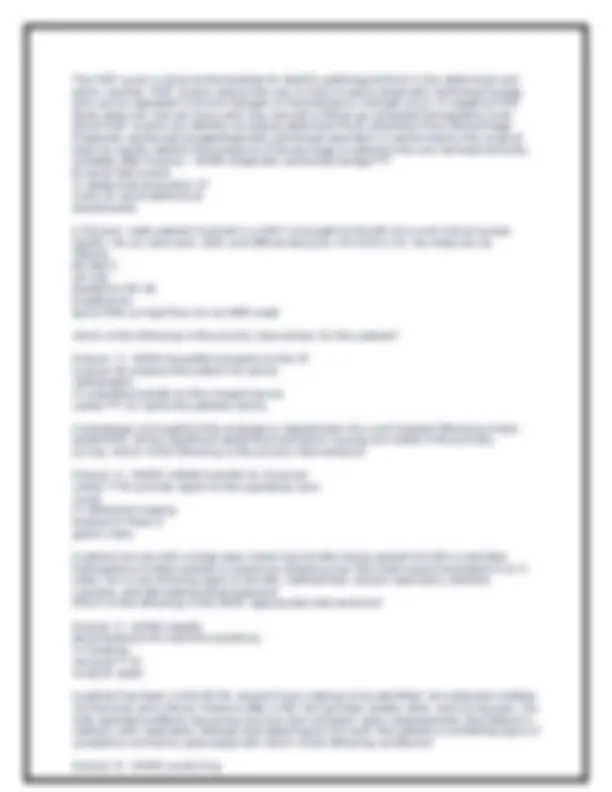

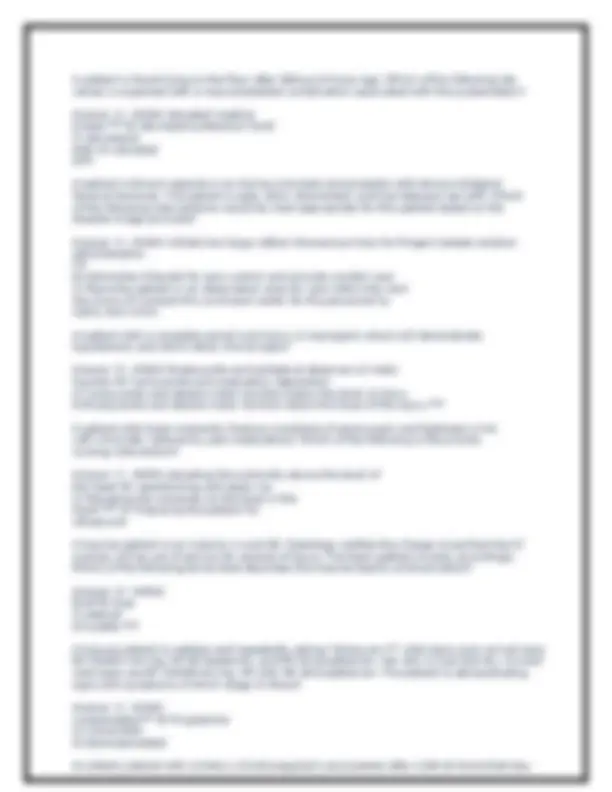
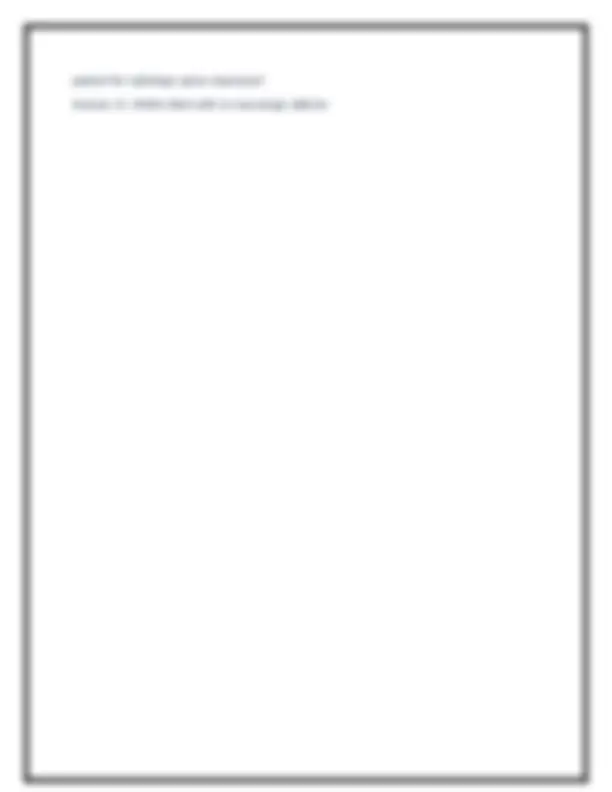
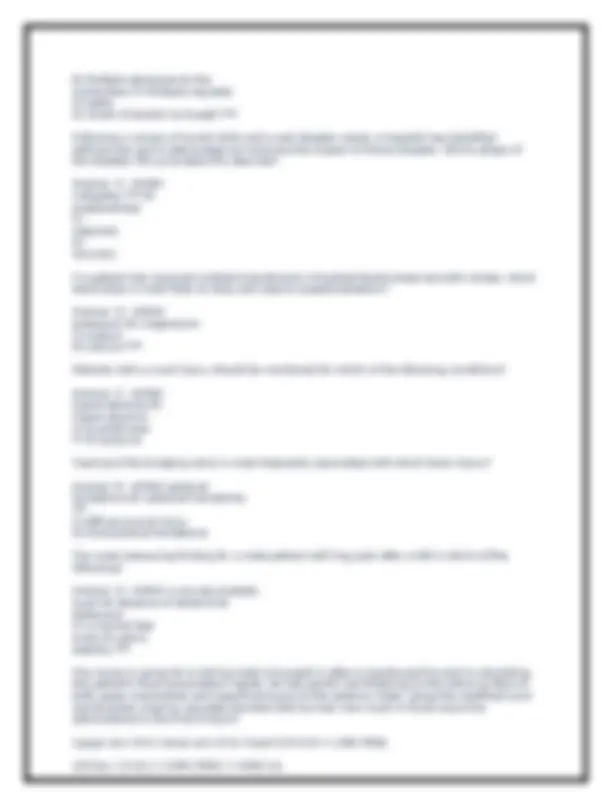
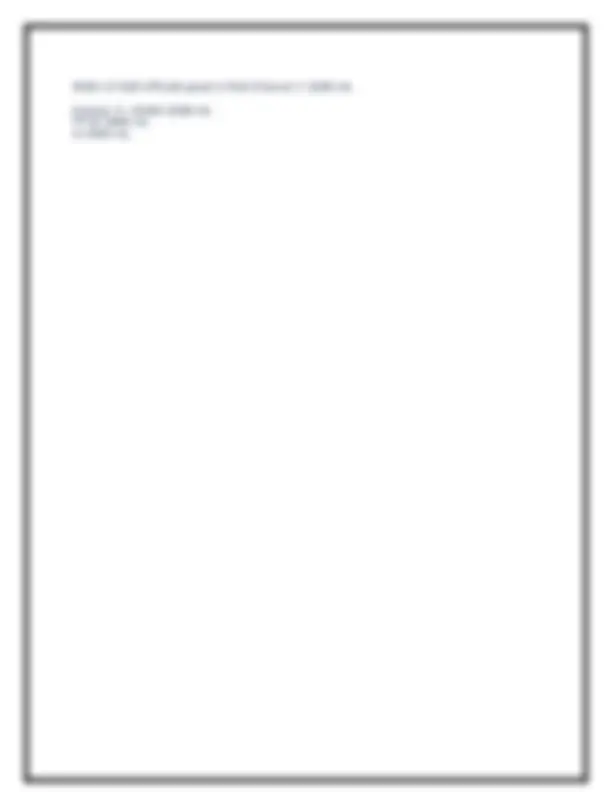
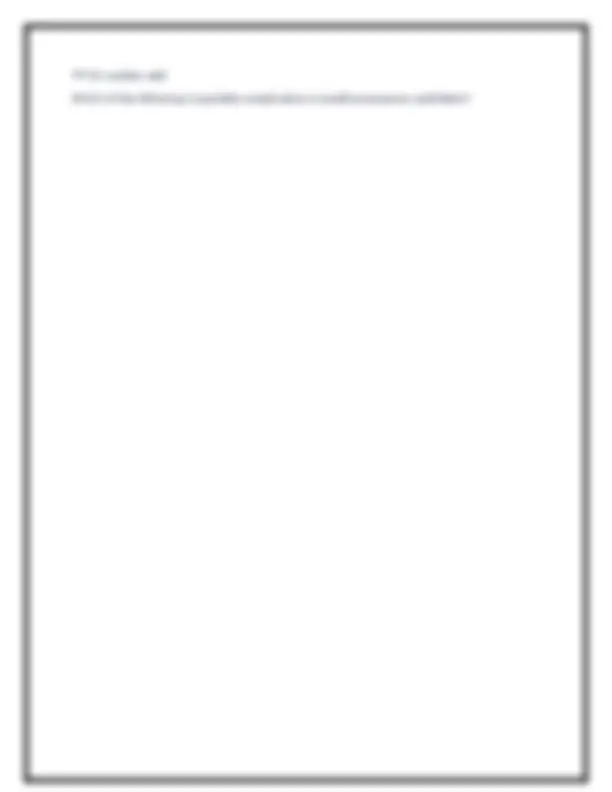
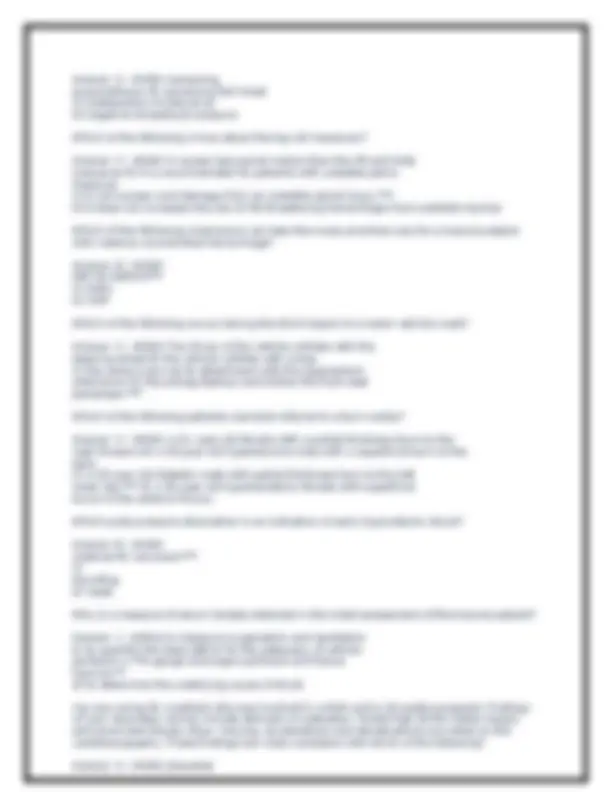



Study with the several resources on Docsity

Earn points by helping other students or get them with a premium plan


Prepare for your exams
Study with the several resources on Docsity

Earn points to download
Earn points by helping other students or get them with a premium plan
Community
Ask the community for help and clear up your study doubts
Discover the best universities in your country according to Docsity users
Free resources
Download our free guides on studying techniques, anxiety management strategies, and thesis advice from Docsity tutors
Various scenarios and questions related to trauma assessment and management in emergency medical settings. It includes topics such as identifying and treating injuries, managing airway and breathing, assessing and responding to shock, and prioritizing care for trauma patients. Detailed information on the appropriate interventions and decision-making processes for different types of traumatic injuries, including fractures, chest injuries, head injuries, and burns. It also covers important concepts like the fast exam, spinal immobilization, and the use of diagnostic tests like ct scans and lab work. Overall, this document serves as a comprehensive resource for healthcare professionals involved in the care of trauma patients, covering a wide range of critical skills and knowledge required in this field.
Typology: Exams
1 / 16

This page cannot be seen from the preview
Don't miss anything!










A 5-year old child presents to the ED with bruises to the upper arms and buttocks in
various stages of healing and multiple small, clean, round burns to the back. There are no
abnormalities found based on the pediatric assessment triangle or primary survey. Which
of the following is the priority nursing
interventio
n?
Answer: A - ANSA) report your suspicion of the maltreatment in accordance with local
regulations *** B) apply ice to the bruises and consult wound care
C) engage in therapeutic communication to determine
the MOI D) provide the family with injury prevention
resourse
A 20-year old male presents to the ED c/o severe lower abd pain after landing hard on the
bicycle cross bars which performing an aerial BMX maneuver. Secondary assessment
reveals lower abd tenderness and scrotal ecchymosis. Which of the following orders would
the nurse questions?
Answer: C - ANSA) Fast
exam B) CT scan
C) straight cath for urine
sample *** D) ice and
elevation of the scrotum
A 35-year old male presents with facial trauma after bring struck inthe face with a
baseball. a tear-drop shaped left pupil is noted on exam. What type of injury is
suspected?
Answer: B - ANSA) oculomotor nerve
palsy B) globe rupture ***
C) uncal
herniation D)
retinal
detachment
A 36-year old female has a deformity of the left wrist after a fall. She is reluctant to move her
hand due to pain. Which of the following is the most appropriate intervention?
Answer: B - ANSA) apply a sling and elevate the extremity to the level of
the heart. B) apply a splint and ELEVATE ABOVE THE LEVEL OF THE
C) Apply a sling and elevate the extremity above the level of
the heart D) apply a splint and elevate the extremity to the
level of the heart.
A 49-year old restrained driver involved in a MVC presents to the trauma center c/o abd,
pelvic, and bil
lower extremity
pain Vitals signs are stable. The nurse can anticipate all of these
negative fast exam except which of the following?
Answer: A
injury B) fat embolism ***
D) pulmonary contusion
A patient is found lying on the floor after falling 13 hours ago. Which of the following lab
values is expected with a musculoskeletal complication associated with this presentation?
Answer: A - ANSA) elevated creatine
kinase *** B) decreased potassium level
C) decreased
WBC D) elevated
A patient is thrown against a car during a tornado and presents with obvious bilateral
femoral fractures. The patient is pale, alert, disoriented, and has delayed cap refill. Which
of the following interventions would be most appropriate for this patient based on the
disaster triage principle?
Answer: A - ANSA) initiate two large caliber intravenous lines for Ringers lactate solution
administration
B) Administer Dilaudid for pain control and provide comfort care
C) Place the patient in an observation area for care within the next
few hours D) Contact the command center for the personnel to
notify next of kin.
A patient with a complete spinal cord injury in neurogenic shock will demonstrate
hypotension and which other clinical signs?
Answer: D - ANSA) Bradycardia and ipsilateral absences of motor
function B) Tachycardia and respiratory depression
C) Tachycardia and absent motor function below the level of injury
D) Bradycardia and absent motor function below the level of the injury ***
A patient with lower extremity fracture complains of severe pain and tightness in his
calf, minimally relieved by pain medications. Which of the following is the priority
nursing intervention?
Answer: C - ANSA) elevating the extremity above the level of
the heart B) repositioning and apply ice
C) Elevating the extremity to the level of the
heart *** D) Preparing the patient for
ultrasound
A trauma patient is en route to a rural ED. Radiology notifies the charge nurse that the CT
scanner will be out of service for several of hours. The team gathers to plan accordingly.
Which of the following terms best describes this trauma teams communication?
Answer: D - ANSA)
Brief B) loop
C) debrief
D) huddle ***
A trauma patient is restless and repeatedly asking "where am I?" vital signs upon arrival were
BP 100/60 mm Hg, HR 96 beats/min, and RR 24 breaths/min. Her skin is cool and dry. Current
vital signs are BP 104/84mm Hg, HR 108, RR 28 breaths/min. The patient is demonstrating
signs and symptoms of which stage of shock?
Answer: A - ANSA)
compensated ** B) Progressive
C) irreversible
D) decompensated
An elderly patient with a history of anticoagulant use presents after a fall at home that day.
Answer: D - ANSA) epidural
hematoma B) diffuse axonal injury
C) post-concussive
syndrome D) subdural
hematoma ***
An intubated trauma patient is being transferred to a tertiary care center. After moving the
patient to the stretcher for transport, a drop in pulse oximetry to 85% is noted. Which of the
following is the priority
intervention
s?
Answer: D - ANSA) call for a portable CXR
stat B) chest to make sure the ventilator is
plugged in C) suction the ET tube
D) confirm ET tube placement
An unresponsive trauma patient has an oropharyngeal airway in place, shallow and
labored respiratory, and dusky skin. the trauma team has administered medications for
drug assisted intubation and attempted intubation but was unsuccessful. What is the most
appropriate immediate next step?
Answer: A - ANSA) Ventilate with a
BVM *** B) Prepare for
cricothyroidotomy
C) administer reversal
medications D) contact
anesthesia for assistance
Caregivers carry a 2-year old into the ED who fell out of 2nd story window. The patient is
awake and crying with increased work of breathing and pale skin. which of the following
interventions has the highest priority?
Answer: A - ANSA) padding the upper back while stabilizing the cervical
spine *** B) applying a tight-fitting NRB mask with an attached resevior
C) establishing intravenous access and administering a
20mL/kg bolus D) preparing for drug assisted intubation
During the primary survey of an unconscious patient with multi-system trauma, the nurse
notes snoring respirations. Which priority nursing interventions should be performed next?
Answer: D - ANSA) open the airway with the head-tilt/chin lift
maneuver B) auscultate bilateral breath sounds to assess
ventilatory status
C) assist respirations using a BVM
D) insert an oropharyngeal airway if there is no gag reflex ***
EMS arrives with the intoxicated driver of a car involved in a MVC. EMS reports significant
damage to the drivers side of the car. The patient is asking to have the cervical color
removed. when is it appropriate to remove the cervical collar?
Answer: A - ANSA) after a physical examination if the patient has no radiologic
abnormalities on a computed tomography scan ***
B) after physician evaluation if the patient has not neurologic abnormalities on exam
C) after palpation of the spine if the patient has no point tenderness the the
vertebral column D) after physical examination if the patient has not neck pain
with movement
EMS brings a patient who fell riding his bicycle. Using the American College of Surgeons
screening guidelines, which assessment finding would prompt the nurse to prepare the
patient for radiologic spine clearance?
Answer: D - ANSA) Alert with no neurologic deficits
4560 / 2 (half of fluids given in first 8 hours) = 2280 mL
Answer: A - ANSA) 2280 mL
*** B) 3840 mL
C) 4560 mL
D) 7680 mL
The trauma nurse knows that placing a bariatric patients in a "ramped position" provides
better visualization during the insertion of which device?
Answer: C - ANSA) Intraosseous
line B) orogastric tube
C) ET tube ***
D) urinary catheter
What bedside monitoring parameters are used to assess for adequacy of oxygenation and
effectiveness of ventilation?
Answer: A - ANSA) pulse oximetry and
capnogaphy ** B) respiratory rate and
capnography
C) pulse oximetry and
respiratory rate D) capnography
and capnometry
What factor contributes most the kinetic energy of a body in motion?
answer: C - ANSA)
acceleration B) mass
C) velocity
inertia
What finding raises suspicion of complete spinal cord injury?
Answer: B - ANSA) Weakness in the lower
extremities B) Priapism ***
C) voluntary anal sphincter tone
D) intact reflexes distal to the injury
Which if the following values indicates the need for alcohol withdrawal interventions?
Answer: A - ANSA) CIWA-Ar of 36
C) ETCo2 of 48 mm Hg
D) heart rate of 45 beats/min
Which is the effect of hypothermia on the oxyhemoglobin dissociation curve?
Answer: A - ANSA) Hemoglobin does not readily release oxygen for use by the
tissues *** B) The amount of oxygen available to the tissues increases
C) Tissue oxygenation (PaO2) increases
D) Hemoglobin molecule saturation (SaO2) decreases
Which of the following assessment findings differentiates a tension PTX from a simple PTX?
answer: D
Assessment findings associated with tension pneumothorax include anxiety, severe
restlessness, severe respiratory distress, and absent breath sounds on the injured side.
Hypotension due to compression of the heart and great vessels is consistent with
obstructive shock. Hypotension worsens with inspiration due to increased intrathoracic
pressure. Late signs include distended neck veins, tracheal deviation, and cyanosis. - ANSA)
increased work of breathing
*** D) cardiac cath
Which of the following is possible complication of positive-pressure ventilation?
Answer: A - ANSA) worsening
pneumothorax B) worsening flail chest
C) reabsorption of pleural air
D) negative intrapleural pressure
Which of the following is true about the log roll maneuver?
Answer: C - ANSA) it causes less spinal motion than the lift and slide
manuever B) it is recommended for patients with unstable pelvic
fractures
C) it can worsen cord damage from an unstable spinal injury ***
D) it does not increases the risk of life threatening hemorrhage from unstable injuries
Which of the following mnemonics can help the nurse prioritize care for a trauma patient
with massive uncontrolled hemorrhage?
Answer: B - ANSA)
Which of the following occurs during the third impact of a motor vehicle crash?
Answer: C - ANSA) The driver of the vehicle collides with the
steering wheel B) the vehicle collides with a tree
C) the aorta is torn at its attachment with the ligamentum
arteriosum D) the airbag deploys and strikes the front seat
passenger ***
Which of the following patients warrants referral to a burn center?
Answer: C - ANSA) a 21- year old female with a partial thickness burn to the
right forearm B) a 40-year old hypertensive male with a superficial burn to the
back
C) a 52-year old diabetic male with partial thickness burn to the left
lower leg *** D) a 35-year old hyperlipidemic female with superficial
burns to the anterior thorax.
Which pulse pressure description is an indication of early hypovolemic shock?
Answer: B - ANSA)
widened B) narrowed ***
bounding
D) weak
Why is a measure of serum lactate obtained in the initial assessment of the trauma patient?
Answer: c - ANSa) to measure oxygenation and ventilation
b) to quantify the base deficit for the adequacy of cellular
perfusion c) *to gauge end-organ perfusion and tissue
hypoxia **
d) to determine the underlying cause of shock
You are caring for a patient who was involved in a MVA and is 32 weeks pregnant. Findings
of your secondary survey include abd pain on palpation, fundal high at the costal margin,
and some dark bloody show. Varying, accelerations and decelerations are noted on the
cardiotocography. These findings are most consistent with which of the following?
Answer: A - ANSA) placental
D) fetal demise
You are treating a 27-year old male in respiratory distress who was involved in a house fire.
Calculating TBSA burned is deferred d/t the need for emergent intubation. At what rate
should you begin fluid resuscitation?
Answer: B - ANSA) 1000
mL/hr B) 500 mL/hr ***
C) 250 mL/hr
D) 125 mL/hr